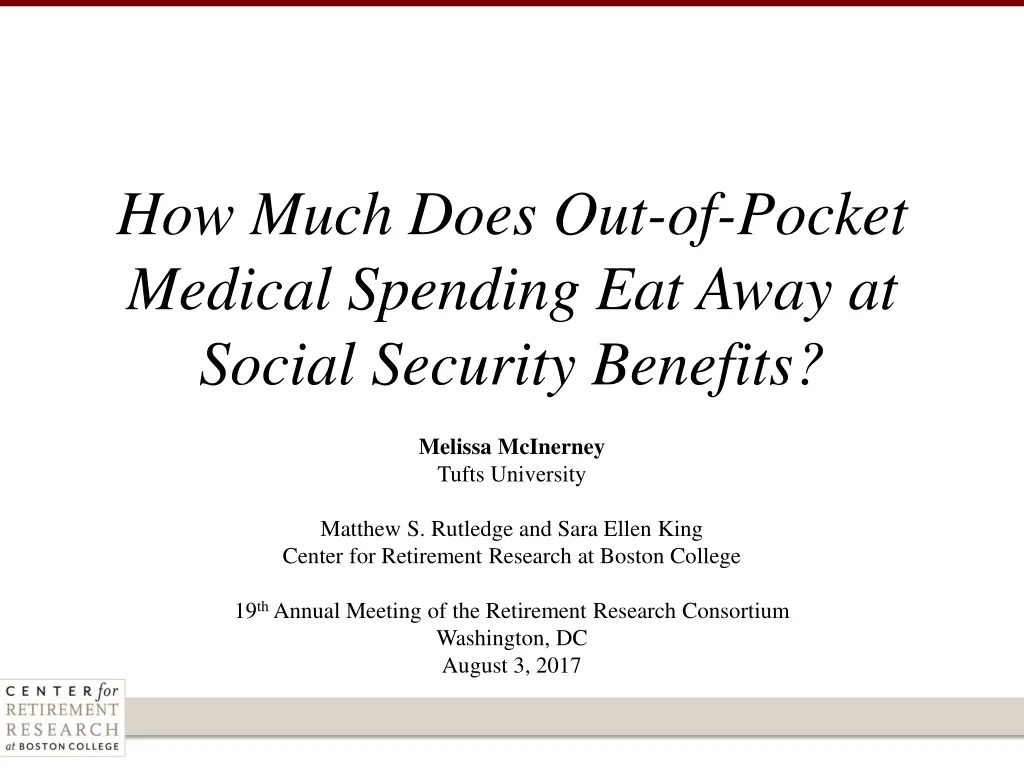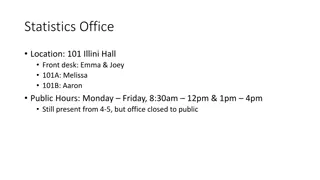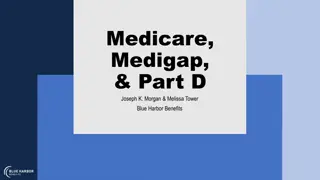
Social Security and Out-of-Pocket Medical Costs Impact on Retirees
Explore the impact of out-of-pocket medical costs on Social Security benefits for retirees, delving into the financial implications and changes after Medicare Part D. Learn about the projected rise in medical spending relative to OASI benefits and how various subgroups are affected differently.
Download Presentation

Please find below an Image/Link to download the presentation.
The content on the website is provided AS IS for your information and personal use only. It may not be sold, licensed, or shared on other websites without obtaining consent from the author. If you encounter any issues during the download, it is possible that the publisher has removed the file from their server.
You are allowed to download the files provided on this website for personal or commercial use, subject to the condition that they are used lawfully. All files are the property of their respective owners.
The content on the website is provided AS IS for your information and personal use only. It may not be sold, licensed, or shared on other websites without obtaining consent from the author.
E N D
Presentation Transcript
How Much Does Out-of-Pocket Medical Spending Eat Away at Social Security Benefits? Melissa McInerney Tufts University Matthew S. Rutledge and Sara Ellen King Center for Retirement Research at Boston College 19th Annual Meeting of the Retirement Research Consortium Washington, DC August 3, 2017
Are Social Security benefits adequate? General public and policy analysts tend to evaluate benefit adequacy based on total retirement income provided. More relevant to consider retirees purchasing power, net of nondiscretionary Out-of-Pocket (OOP) medical costs. This project examines Social Security income net of OOP medical costs from 2002-2014 using the Health and Retirement Study (HRS). 1
Retirees covered by Medicare face high Out- of-Pocket (OOP) medical costs. Premiums Part B ($1,258 for most retirees) Part D ($175-$800 year for retiree in Boston) Supplemental insurance (Medigap, Retiree Health Insurance) Medicare Advantage (up to $1,742/year for retiree in Boston) o o o o Cost-sharing for covered services Part A ($1,216 deductible for first 60 days, $304-$608/day for days 60+) Part B ($147 deductible per year, 20% coinsurance) Part D ($310 deductible, 25% coinsurance over next $2,520 in drug spending, donut hole over next $3,610 in spending, 25% coinsurance above donut hole) o o o Cost of uncovered services (e.g., dental, vision) Average of $197,000 in lifetime OOP costs Webb and Zhivan (2010) o 2
This project examines how Social Security income net of OOP differs across retirees. Decomposes OOP by type of spending (premiums or costs of services received). Examines whether subgroups differ in OOP spending and the share of Social Security benefits remaining net of OOP by age, supplemental insurance, income quintile, and health status. Allows for the examination of the change in OASI income net of OOP costs after Medicare Part D (2006) and closure of the donut hole began (2010). 3
Prior evidence In 2011, retirees enrolled in traditional (fee-for-service) Medicare spent $3,600 on OOP (Noel-Miller, 2015). Share of Social Security income remaining net of OOP medical costs lower for: o Older adults, o Near poor who do not qualify for Medicaid, o Those in the worst health, and o Those who purchase private supplemental insurance o (Cubanski et al., 2015; Akincigil and Zurlo, 2015; Noel-Miller, 2015). OOP medical spending projected to increase in the future at a faster rate than growth in OASI benefits (Favreault and Johnson, 2016; Medicare Trustees, 2017). 4
Health and Retirement Study (HRS) 2002- 2014 Sample: o 65 years+ o Receiving Social Security and Medicare o Not working full time o Not receiving health insurance through employer o Reside in the community Social Security income OOP medical costs o Costs for premiums, cost sharing, and uncovered services OASIbenefi ( ) t OOP = it it Post OOPbenefit it OASIbenefi t it 5
Average retiree spent $3,066 on OOP in 2014. Medical Out-of-Pocket Spending in 2014, by Spending Type and Percentile $9,000 Other OOP Premiums $6,000 $3,000 $0 Mean 25th 50th 75th 90th 95th Percentile of out-of-pocket medical spending Source: Health and Retirement Study, 2014. 6
Average retiree has 75% of Social Security income remaining after OOP. Share of Social Security Income Remaining after Medical Out-of-Pocket Spending in 2014, by Spending Type and Percentile 100% Percent of Social Security income 75% 50% 25% 0% Mean 5th Percentile of post-OOP ratio Premiums Other OOP 10th 25th 50th 75th Remaining Source: Health and Retirement Study, 2014. 7
Share of OASI remaining varies by type of supplemental insurance. Average Share of Social Security Income Remaining after Medical Out-of-Pocket Spending in 2014, by Supplemental Insurance Status Percent of Social Security income 100% 75% 50% 25% 0% Premiums Other OOP Remaining Source: Health and Retirement Study, 2014. 8
Post-OOP benefit ratio does not vary much by age. Average Share of Social Security Income Remaining after Medical Out-of-Pocket Spending in 2014, by Age 100% Percent of Social Security income 75% 50% 25% 0% All 65-69 70-74 75-79 80+ Premiums Other OOP Remaining Source: Health and Retirement Study, 2014. 9
Middle income households pay more for supplemental coverage to cover OOP costs. Average Share of Social Security Income Remaining after Medical Out-of-Pocket Spending in 2014, by Household Income Quintile 100% Percent of Social Security income 75% 50% 25% 0% All Lowest 2nd 3rd 4th Highest Premiums Other OOP Remaining Source: Health and Retirement Study, 2014. 10
Modest differences by health status. Average Share of Social Security Income Remaining after Medical Out-of-Pocket Spending in 2014, by Health Status 100% Percent of Social Security income 75% 50% 25% 0% All 0-1 ADLs 2+ ADLs No Chronic Chronic Remaining Premiums Other OOP Source: Health and Retirement Study, 2014. 11
Evidence on the 2014 Post-OOP benefit ratio Average retiree spends over $3,000 on OOP costs, more than one quarter of his Social Security income. Post-OOP benefit ratio differs by supplemental insurance. Among community dwellers, no large differences by age in the post- OOP benefit ratio. Middle income households pay sizable premiums yet still have low post-OOP benefit ratios. Sicker retirees have slightly lower post-OOP benefit ratios than healthy retirees. 12
Medical spending by retirees declined from 2002-2014 throughout the distribution. Medical Out-of-Pocket Spending, 2002-2014, by Percentile $14,000 90th 75th Mean 50th $12,000 $10,000 $8,000 $6,000 $4,000 $2,000 $0 2002 2004 2006 2008 2010 2012 2014 Source: Health and Retirement Study, 2002-2014. 13
Mean post-OOP benefit ratio increased 7.3 percentage points between 2004 and 2014. Share of Social Security Income Remaining after Medical Out-of-Pocket Spending, 2002-2014, by Percentile 100% 80% 60% 40% 20% 10th 25th Mean 50th 0% -20% 2002 2004 2006 2008 2010 2012 2014 Source: Health and Retirement Study, 2002-2014. 14
Largest gains for groups that benefit the most from supplemental drug coverage. Average Share of Social Security Income Remaining after Medical Out-of-Pocket Spending, 2002-2014, by Supplemental Insurance Status 100% 75% 50% MedAdv Medicaid Medicare RHI 25% 0% 2002 2004 2006 2008 2010 2012 2014 Source: Health and Retirement Study, 2002-2014. 15
Largest gains for those with chronic conditions. Average Share of Social Security Income Remaining after Medical Out-of-Pocket Spending, 2002-2014, by Chronic Conditions 100% 2004 2014 76.3% 74.4% 73.2% 75% 65.8% 50% 25% 0% No Chronic Chronic Source: Health and Retirement Study, 2002-2014. 16
Conclusion In 2014, the average retiree has only 75 percent of his benefit left for non-medical spending. Premiums comprise the largest share of medical spending for most retirees. Evidence consistent with benefit adequacy rising after Medicare Part D (2006) and donut hole closure (began 2010). When Medicare costs rise again, Social Security beneficiaries likely to feel further pressure on their budgets. 17





















